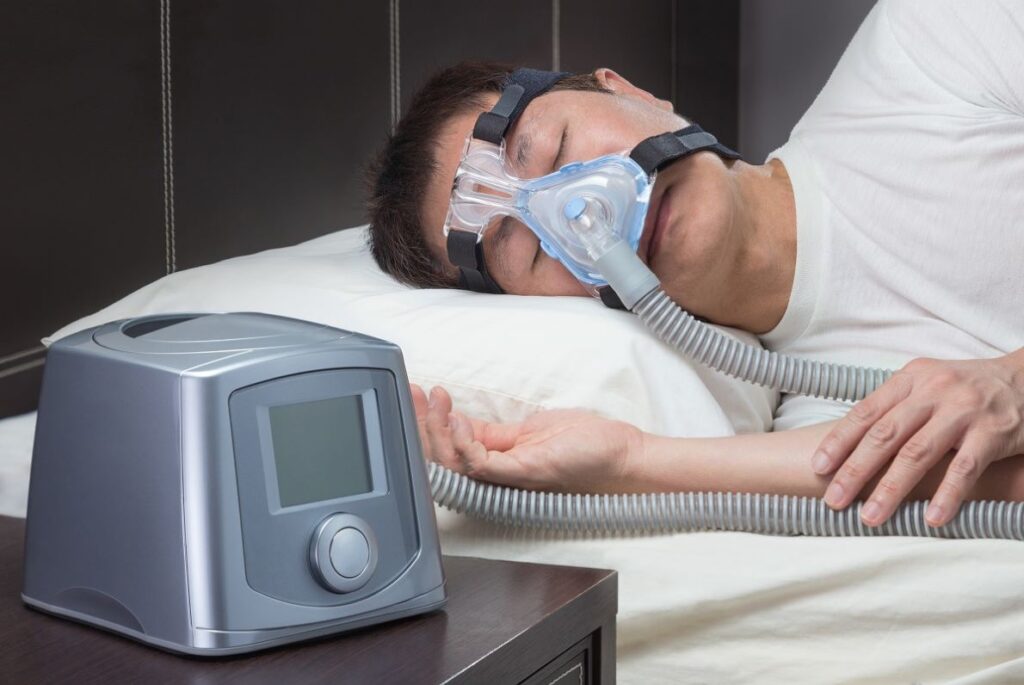Almost everyone snores from time to time — after a long day, during allergy season, or after a glass of wine. But when snoring becomes chronic, it can be more than just a nighttime nuisance. It might be a sign of sleep apnea, a serious sleep disorder that affects not only your sleep quality but also your overall cardiovascular health.
Understanding the difference between snoring and sleep apnea is crucial for protecting your long-term health. Let’s break down what sets these two conditions apart, how to recognize the warning signs, and what treatments — including CPAP therapy — can help you breathe easier and sleep better.
Snoring vs. Sleep Apnea: What’s the Core Difference?
At first glance, snoring and sleep apnea may sound similar — both involve noise during sleep and restricted airflow. However, their causes, severity, and health risks differ significantly.
Snoring: A Common but Often Harmless Sound
Snoring happens when airflow through your mouth or nose is partially blocked. This causes the soft tissues in your throat and mouth to vibrate, producing that familiar rumbling sound.
Common causes of snoring include:
- Nasal congestion or allergies
- Sleeping on your back
- Being overweight
- Drinking alcohol before bed
- Relaxation of throat muscles during sleep
For most people, snoring is a benign condition — annoying but not dangerous. However, in some cases, it’s a warning sign of something more serious.
Sleep Apnea: When Snoring Turns Dangerous
Sleep apnea, on the other hand, is a sleep disorder where your breathing repeatedly stops and starts during the night. Each pause (called an “apneic episode”) can last several seconds or longer, drastically lowering oxygen levels in your blood.
There are three main types of sleep apnea:
- Obstructive Sleep Apnea (OSA): Caused by physical blockage of the airway due to relaxed throat muscles.
- Central Sleep Apnea: Occurs when the brain fails to send the right signals to breathing muscles.
- Complex Sleep Apnea: A combination of both obstructive and central types.
Unlike snoring, sleep apnea interrupts normal breathing and sleep cycles, which can have serious health consequences over time.
Why Sleep Apnea Is More Dangerous Than Snoring
While snoring is often just an inconvenience, sleep apnea can be life-threatening if left untreated. The main issue lies in oxygen deprivation.
Each time your breathing stops, oxygen levels in your blood drop. Your body senses this and triggers a “fight-or-flight” response — your heart rate spikes, and your brain wakes you up briefly to resume breathing. This can happen dozens or even hundreds of times per night, putting your body under constant stress.
The Cardiovascular Impact
Repeated drops in oxygen (a condition called intermittent hypoxia) cause long-term damage to the heart and blood vessels. According to research from the American Heart Association, untreated sleep apnea is linked to:
- High blood pressure (hypertension)
- Heart arrhythmias (irregular heartbeats)
- Coronary artery disease
- Heart attacks and heart failure
- Stroke
Over time, this cycle of stress and oxygen deprivation can significantly increase the risk of heart disease and other cardiovascular conditions.

Real-World Example: When Snoring Masks a Serious Problem
Take the example of Sarah, a 48-year-old nurse who had snored for years. Her family thought it was harmless until she began experiencing morning headaches, extreme fatigue, and difficulty concentrating. A sleep study revealed that she had moderate obstructive sleep apnea — her breathing stopped 20 times per hour during the night.
After starting CPAP therapy, her symptoms disappeared, her blood pressure improved, and she felt more energized during the day.
Sarah’s case highlights why it’s essential to distinguish between simple snoring and sleep apnea — and to seek medical help when symptoms persist.
Signs You Might Have Sleep Apnea (and Not Just Snoring)
Here are some symptoms that suggest your snoring could be part of a larger problem:
- Loud, chronic snoring that disturbs others
- Gasping or choking during sleep
- Pauses in breathing noticed by your partner
- Excessive daytime fatigue
- Morning headaches or sore throat
- Difficulty concentrating or memory issues
- Mood swings, irritability, or depression
If you experience several of these signs, it’s important to undergo a sleep study to confirm whether sleep apnea is the cause.
Diagnosing Sleep Apnea: The Role of Sleep Studies
A sleep study (or polysomnography) is the gold standard for diagnosing sleep apnea. This test records various body functions during sleep, including:
- Breathing patterns
- Oxygen levels
- Heart rate and rhythm
- Brain activity
- Muscle movements
Home-based sleep studies are also available for convenience and are often used for diagnosing obstructive sleep apnea. Your results help determine the severity of the condition and guide your treatment plan.
How CPAP Therapy Helps Restore Healthy Sleep
One of the most effective treatments for sleep apnea is Continuous Positive Airway Pressure (CPAP) therapy. The CPAP machine delivers a gentle, continuous stream of air through a mask, keeping your airways open and preventing apneic episodes.
Benefits of CPAP Therapy
- Prevents breathing interruptions
- Improves oxygen levels during sleep
- Reduces daytime fatigue and brain fog
- Lowers blood pressure and heart strain
- Enhances mood and overall sleep quality
Many patients report dramatic improvements in both energy levels and cardiovascular health within weeks of consistent CPAP use.
Other Effective Treatments and Lifestyle Adjustments
While CPAP therapy remains the gold standard, some people benefit from additional or alternative methods:
Lifestyle Changes
- Lose excess weight: Even a modest reduction can decrease apnea severity.
- Avoid alcohol and sedatives: These relax throat muscles and worsen obstruction.
- Sleep on your side: Helps keep the airway open naturally.
- Exercise regularly: Improves breathing and cardiovascular function.
Oral Appliances
Dentists can fit oral appliances that reposition the jaw or tongue to reduce airway collapse — ideal for those with mild to moderate sleep apnea.
Surgical Options
For severe cases, procedures like uvulopalatopharyngoplasty (UPPP) or nasal surgery may be recommended to remove excess tissue or correct structural problems.
Sleep Apnea, Snoring, and Heart Disease: The Hidden Link
People often underestimate how closely sleep apnea and heart disease are connected. The constant drops in oxygen trigger inflammation, oxidative stress, and increased blood pressure — all of which damage the heart over time.
In contrast, simple snoring doesn’t typically cause these effects. That’s why identifying and treating sleep apnea early is one of the best ways to protect both your sleep health and cardiovascular health.
Key Takeaways
- Not all snoring is harmless — persistent, loud snoring may signal sleep apnea.
- Sleep apnea causes oxygen deprivation, leading to heart strain and higher cardiovascular risks.
- Sleep studies can accurately diagnose the condition.
- CPAP therapy and lifestyle changes are proven to restore normal breathing and improve heart health.
- Early diagnosis can prevent long-term complications and restore energy, focus, and sleep quality.
FAQS
Sleep apnea causes repeated drops in oxygen levels during sleep, forcing the heart to work harder. Over time, this can lead to high blood pressure, irregular heartbeats, heart attacks, and even heart failure. Treating sleep apnea early significantly lowers cardiovascular risks.
Yes. Research shows that managing sleep apnea — especially through consistent CPAP therapy — reduces strain on the heart, lowers blood pressure, and improves circulation. Patients who treat their sleep apnea often experience better heart function and overall cardiovascular health.
No. While CPAP therapy is the most effective for moderate to severe cases, lifestyle changes such as losing weight, avoiding alcohol, sleeping on your side, and using oral appliances can help manage mild sleep apnea and support heart health.
Men over 40, individuals who are overweight, smoke, or have high blood pressure are at higher risk. However, women and younger adults can also develop both conditions — especially if they experience chronic snoring or daytime fatigue.

